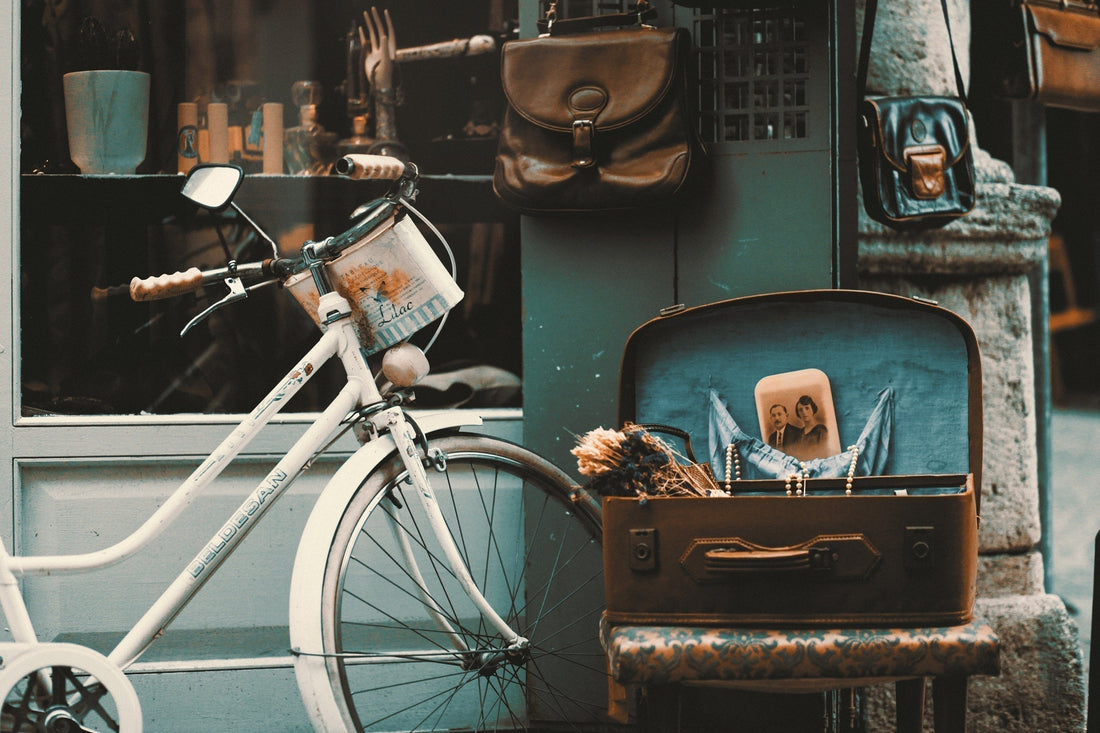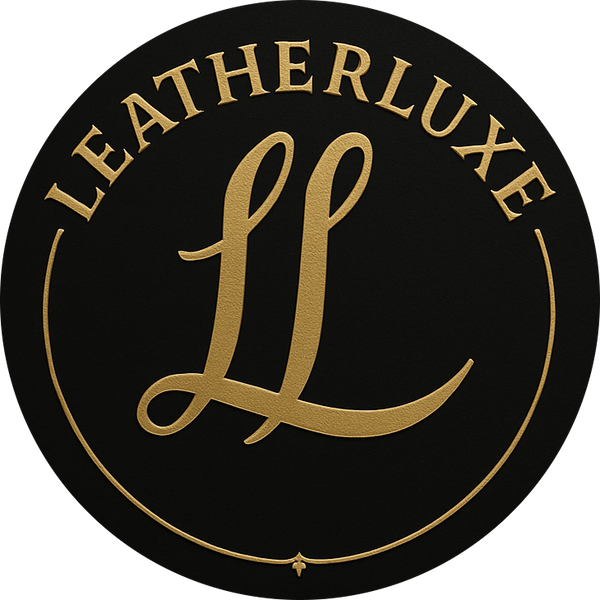
The Influence of Real Leather Bag Designs Throughout History
From medieval belt pouches to 20th-century icons and today’s refined minimalism, leather bags have mirrored the way we live, travel, and express style. Here’s how centuries of craftsmanship shaped the silhouettes we carry now — and how LeatherLuxe interprets those classics for the modern wardrobe.
Beginnings: Carrying the essentials, ancient to classical
Long before “handbag” became a fashion term, humans relied on simple pouches and satchels to carry tools, food, and valuables. Early leather containers were prized because well-tanned hide is supple, strong, and naturally weather-resistant. In the classical world, soldiers and travelers carried small kit bags — the loculus — slung across the body for hands-free practicality. That cross-body, work-ready idea foreshadows the messenger and satchel silhouettes we still love today.
While the archaeological record for everyday leather rarely survives (leather decays), surviving fittings and depictions tell the story: bags were utilitarian first, then gradually decorated to signal craft, identity, and status.
Medieval & Renaissance: Girdle purses and status
In medieval Europe, clothing typically lacked sewn-in pockets, so men and women wore coin purses and pouches suspended from belts or girdles. These drawstring leather purses — sometimes richly embellished with metal frames or embroidery — were functional, but they also communicated rank and taste. Artefacts like purse lids and metal frames survive in museums even when the original leather has perished, reminding us how widespread (and important) these accessories were.
By the 15th and 16th centuries, metal-framed pouches and “kidney” shaped leather bags appear in portraits and inventories across Europe. The message is clear: a well-made purse didn’t just hold coins; it said something about the wearer’s worldliness and means.
18th–19th Centuries: Chatelaines, reticules & the rise of handbags
As tailoring evolved, men’s clothing began to incorporate interior pockets, reducing the need for external pouches. Women’s dress, however, often required small external carry-alls. Enter the chatelaine — a decorative belt hook suspending chains for keys, scissors, vinaigrettes and small purses — part utility, part jewellery.
At the turn of the 19th century, the Empire line silhouette favoured lightweight gowns; bulky pockets vanished, and small drawstring evening bags known as reticules appeared. Typically crafted in silk or fine leather, reticules were elegant, handheld, and just big enough for a handkerchief, calling card, or vinaigrette. In short: the handbag as a distinctly fashionable object had arrived.
Industrialisation and rail travel later accelerated innovation. As mobility increased, so did the demand for sturdier leathers, reliable closures, and specialised shapes for documents, toiletries, and jewellery. Vanity cases, frame bags, and carpet bags became part of a growing lexicon of purpose-built carry.
Modernity & Mobility: Travel, zippers, and the birth of icons
The early 20th century supercharged design. Luggage makers refined travel pieces into streamlined handbags that balanced elegance with function. A pivotal moment came in the 1920s with the adoption of the modern zipper in luxury leather goods — dramatically improving security and ease of access. From there, a golden age of silhouettes followed, as houses codified signatures that still define luxury today.
Why the zipper mattered
The addition of a metal zipper to a leather bag created a new class of secure, travel-friendly handbags. It set expectations for performance in everyday carry and helped standardise the tidy, domed top-zip shape we still associate with refined “carry-all” styles.
Mid-century liberation: straps go mainstream
Post-war dressing emphasised mobility. Shoulder straps and chain straps freed the hands; quilted textures and turn-locks added tactile pleasure and security. The combination of form and function gave birth to icons that feel as fresh now as they did then.
The “It-Bag” Era: 1990s–2000s pop-culture legends
As fashion globalised, the handbag became a cultural signal: a shorthand for taste, lifestyle, and belonging. Design houses introduced styles that captured a moment — and then transcended it. A few milestones you can still spot across runways and city streets today:
- The quilted chain-strap classic (1955): a milestone shoulder bag with a sliding chain that kept hands free, wrapping practicality in couture refinement.
- The structured top-handle (1930s; renamed in the 1950s): a trapezoid, strap-belted silhouette that reads polished yet modern — proof that a clean architectural shape never dates.
- The travel-born top-zip (1920s → 20th-century staple): a domed, zip-top design engineered for speed and security — the ancestor of many contemporary city totes.
- The under-arm baguette (1997): compact, tucked under the arm, instantly recognisable; a true “first It-bag” phenomenon of the late ’90s that still sparks re-issues.
- The asymmetrical saddle (1999): a curvy short-strap silhouette that defined Y2K cool and later returned as a modern crossbody favourite.
These designs captured more than aesthetics — they mapped to lifestyles: commuting, nightlife, international travel, and the growing desire to be hands-free without sacrificing polish.
Craft & Materials: Tanning, grains & why quality lasts
Leather’s beauty starts in the tannery. Tanning converts raw hide into durable leather by stabilising the collagen fibres. Two foundational approaches dominate fine bag-making:
Vegetable tanning
A traditional process that uses plant tannins (from bark and leaves) to gently transform hide over weeks. Vegetable-tanned leather develops a rich patina, holds structure beautifully, and reads luxurious to the touch. It’s a favourite for structured silhouettes, saddlery-inspired pieces, and heirloom goods.
Chrome tanning
Introduced in the 19th century, chrome tanning uses mineral salts to achieve a soft, even temper quickly, with excellent colour versatility. It’s ideal for supple, drapey bags and precise hues across seasons.
Leather grains (what the terms really mean)
- Full-grain: the top surface of the hide, minimally corrected. Highest durability, most natural character, best patina over time.
- Top-grain: lightly corrected or sanded for a smoother surface, balancing durability with a refined, uniform look — great for premium everyday bags.
- Corrected-grain: more heavily buffed and embossed for uniformity and stain resistance; useful for high-wear pieces and crisp textures.
There’s no single “best” — the right choice depends on the silhouette, finish, colour depth, and the wearer’s lifestyle. The constant: careful selection and skilled construction turn good leather into a bag that gets better with every carry.
LeatherLuxe Design Notes: Heritage, reimagined
At LeatherLuxe, we take the most timeless lessons from history — proportion, balance, and function — and distill them into modern silhouettes designed for Australian lifestyles.

Why it works: The softly structured body and zip closure give you commuter-proof security; the refined top-grain leather delivers a smooth, uniform finish that plays beautifully with tailoring or denim.

How we spec our leathers: We prioritise hides with consistent grain, balanced temper, and finishes that resist day-to-day scuffs without looking plasticised. Hardware is chosen for longevity (smooth zips, quiet clasps), and interiors are lined for clean organisation.
How to choose your next leather bag (style, utility, longevity)
Match silhouette to routine
- Everyday commute: a zip-top shoulder or bucket bag with internal pockets for phone, keys, and a small notebook.
- Hands-free weekends: a compact satchel or crossbody with a secure flap or zip.
- Polished occasions: a structured top-handle or compact under-arm profile that reads streamlined in photos.
Check construction details
- Seams & stress points: neat stitching with reinforcement where straps meet the body.
- Closure quality: smooth, snag-free zips; magnetic clasps that align cleanly; hardware that feels solid, not tinny.
- Edge finishing: painted edges should be even and sealed; raw edges on vegetable-tanned pieces should feel burnished, not fuzzy.
Choose the right leather grain
- Full-grain: you love natural character and a patina that deepens.
- Top-grain: you want a refined, uniform surface with premium durability.
- Corrected-grain: you prefer crisp, durable texture with lower-maintenance cleanup.
Colour strategy
- Navy & olive: sophisticated alternatives to black; pair easily with denim, neutrals, and soft tailoring.
- Taupe & camel: season-less and elevating; they brighten darker outfits without shouting.
- Statement shades: choose one signature hue that ties to your wardrobe accents (scarves, shoes, outerwear trim).
Care tips to keep leather beautiful for years
- Rotate and rest: leather benefits from downtime to release moisture picked up during wear.
- Store with shape: use the dust bag; stuff lightly with acid-free paper; avoid over-packed shelves that press handles.
- Wipe routinely: a soft, dry cloth after wear; for light soil, a barely damp cloth and quick dry away from heat.
- Condition sparingly: occasional neutral conditioner for vegetable-tanned or drier leathers; test on an unseen area first.
- Mind the weather: light rain isn’t fatal; blot, don’t rub. For frequent wet conditions, choose finishes formulated for moisture resistance.
Closing thoughts
Across centuries, leather bags evolved alongside our lives — from belt-hung purses to refined icons and streamlined crossbodies. What endures is the marriage of utility and beauty: the feel of good leather, the satisfaction of a precise closure, the quiet confidence of a shape that simply works. If you’re building a wardrobe that lasts, choose silhouettes with history in their bones and materials that grow lovelier with time. That’s the LeatherLuxe way.
Frequently Asked Questions
Which eras most shaped modern leather bag design?
From medieval belt pouches and 18th–19th century reticules to 1920s zip-top travel bags, mid-century shoulder silhouettes, and 1990s “It-bags,” each era refined function, hardware, and proportion that influence today’s styles.
Why does real leather age better than alternatives?
Real leather develops a natural patina, softens while holding structure, and can be conditioned and repaired—traits that come from the material’s fiber structure and traditional craftsmanship.
How do I choose a bag inspired by heritage design for modern use?
Match historic silhouettes to daily needs: satchels and cross-bodies for hands-free wear, structured top-handles for polish, and zip-top totes for commuting. Prioritize stitching quality, lining, zips, and hardware.
What’s the best way to care for leather so it lasts decades?
Wipe after use, air-dry away from heat, condition sparingly, and store stuffed to keep shape. Keep away from prolonged moisture and direct sun to preserve color and finish.
How do real and faux leather differ over time?
Faux leather often cracks and peels as the surface coating degrades; real leather can be cleaned, re-conditioned, and repaired, typically gaining character rather than wearing out.
